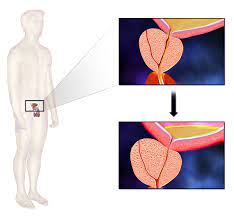First Off
The prevalent disorder known as benign prostatic hyperplasia (BPH), which mostly affects older men, is characterized by the non-cancerous growth of the prostate gland. Men’s prostate glands tend to expand with age, which can cause a variety of urinary symptoms. An extensive review of BPH is given in this article, along with information on risk factors, symptoms, diagnosis, and management options that include medication, surgery, and lifestyle modifications.
Comprehending BPH
A walnut-sized structure that surrounds the urethra in men, the prostate gland is essential to the reproductive system. Prostate tissue grows as a result of hormonal changes brought on by aging, especially an increase in dihydrotestosterone (DHT), which causes BPH. Frequent urination, trouble starting or stopping, weak urine flow, and the sensation that the bladder is not completely emptied are common symptoms.
Risk Factors
The following are some of the causes that lead to the development of BPH:
Age: Men over 50 have a much higher chance of developing BPH, with the condition being more common in older men.
Family History: Having a BPH-afflicted family raises your risk of getting the illness.
Hormonal Changes: Prostate gland enlargement is a result of hormone imbalances, namely an increase in DHT.
Obesity: People who are obese have a higher chance of BPH.
Lifestyle Factors: A sedentary lifestyle, inactivity, and unhealthful eating habits can raise the risk.
Medical disorders: A higher risk of BPH has been linked to a number of medical disorders, including diabetes and heart disease.
Assessment
A complete medical history, physical examination, digital rectal examination (DRE), and a number of tests, such as a urinalysis and a blood test for the prostate-specific antigen (PSA), are necessary for a correct diagnosis of BPH. Further imaging tests, such as a cystoscopy or ultrasound, may be carried out to determine the extent of the illness and rule out any underlying problems.
Techniques of Management
Medication Management: Alpha-Blockers: These drugs improve urine flow by relaxing the muscles surrounding the bladder and prostate. Tamsulosin and Terazosin are two examples.
- Alpha Reductase Inhibitors: These medications, which include finasteride and dutasteride, slow down the prostate gland’s growth by lowering DHT production.
Combination therapy: A combination of 5-alpha reductase inhibitors and alpha-blockers may be beneficial for certain people.
Surgical Procedures:
Transurethral Resection of the Prostate (TURP): To enhance urine flow, this frequently performed surgical treatment includes excising extra prostate tissue.
Laser therapy: Prostate tissue can be removed or vaporized using lasers in procedures like GreenLight Laser Therapy and Holmium Laser Enucleation of the Prostate (HoLEP).
Minimally Invasive Procedures: Using small implants, UroLift and other similar procedures raise and retain the enlarged prostate tissue, releasing pressure on the urethra.
In summary
BPH is a common condition that affects older men and has a major negative effect on their quality of life. Effective management requires a thorough understanding of the risk factors, symptoms, and available treatments, including medication, surgery, and lifestyle modifications.
It is crucial to confer with medical experts to ascertain the most
Keywords:
- BPH (Benign Prostatic Hyperplasia)
- Prostate Enlargement
- Prostate Health
- Urinary Symptoms
- Prostate Gland
- Aging Men
- Alpha-Blockers
- 5-Alpha Reductase Inhibitors
- TURP (Transurethral Resection of the Prostate)
- Laser Therapy
- Minimally Invasive Procedures
- Lifestyle Changes
- Prostate-Specific Antigen (PSA) Test
- Holmium Laser Enucleation of the Prostate (HoLEP)
- UroLift
- Bladder Training
- Dihydrotestosterone (DHT)
- Prostate Health Awareness
- Prostate Disorders
- Men’s Health



